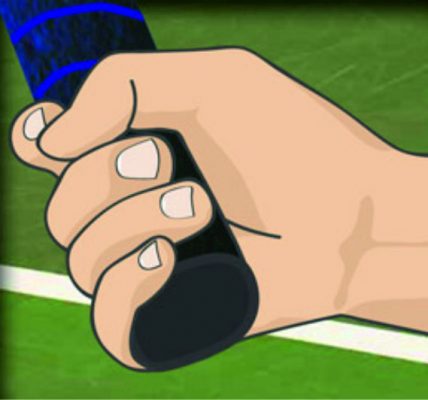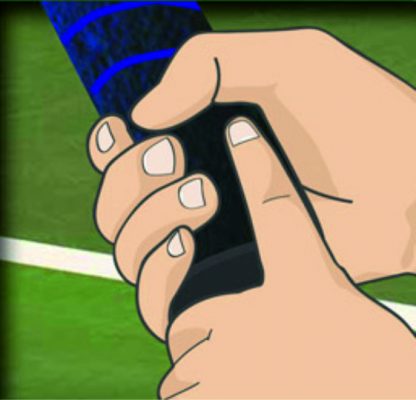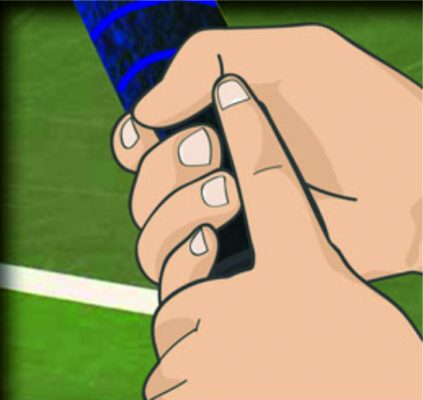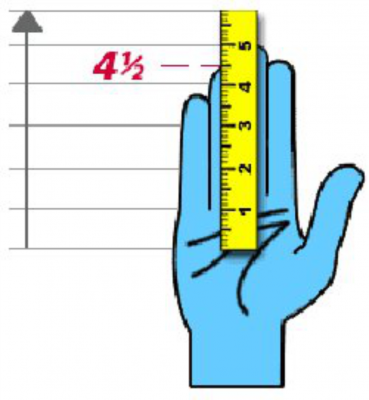
Choosing the right grip size is especially important because the grip is the point of contact between your hand and the racket. Although it may not seem like a difference at first, using the wrong grip size can really affect your entire game, often with adverse consequences. Using an incorrect size can lead to poor performance, irritation, and even hand, wrist, or elbow injuries.
 With a short grip you will need to exert more force to tighten the grip and stabilize it, especially on off sweetspot shots. This causes the muscles of the arm (extensor carpi brevis) to constantly produce work leading to constant strain on the hand and ultimately to problems in the wrist, elbow and tennis elbow.
With a short grip you will need to exert more force to tighten the grip and stabilize it, especially on off sweetspot shots. This causes the muscles of the arm (extensor carpi brevis) to constantly produce work leading to constant strain on the hand and ultimately to problems in the wrist, elbow and tennis elbow.
 With a large grip you will not feel comfortable in your grip, the racket will slip out of your hand and it will be difficult for you to change your grip from forehand to backhand. You will also have a hard time breaking your wrist on serves and overhead shots. You will feel that the racket controls you and not you the racket. And of course again you have to constantly tighten your grip leading to injuries.
With a large grip you will not feel comfortable in your grip, the racket will slip out of your hand and it will be difficult for you to change your grip from forehand to backhand. You will also have a hard time breaking your wrist on serves and overhead shots. You will feel that the racket controls you and not you the racket. And of course again you have to constantly tighten your grip leading to injuries.
 Rule of thumb
Rule of thumb
Holding your racket with Eastern grip (as seen in the photo) the distance between your palm and fingers should correspond to the index finger of your other hand.
 Ruler rule
Ruler rule
If you don’t have a racket with you and want to find the right grip size then an alternative method of finding the size is to measure from the top edge of the middle finger to the base of the side crease of the palm. In this example, the correct grip size is L4.
If in doubt about the correct grip size and between two sizes, go with the smaller size. t is easier to increase your grip than to decrease it.
Another thing to consider before making your choice is the thickness of the overgrip you are going to use. Overgrips range between 0.4mm – 0.75mm and are not all the same as many think, significantly affecting the feel and thickness of your grip.
When we refer to the grip size of a racket we mean its circumference. We measure it in inches or millimeters and this measurement then corresponds to a specific grip size. This size is usually indicated on the butt cap of the racket.

The incorrect positioning of the grip and overgrip is a very common phenomenon. An incorrectly placed overgrip makes it difficult for us to hold our racket properly, because the shape and angles (bevels) of the grip cease to be sharp and also increases the chances of blisters on the palm and fingers. Finally, a properly positioned grip or overgrip makes our racket more aesthetically pleasing.
Special emphasis should be given to left-handed players because the placement of the grip/overgrip should be done oppositely from right-handed players and not the same.
Grip reshaping is needed when a player changes from one racquet company to another and wants to keep the shape of their old grip and is done by using special tape on the appropriate sides of the grip to square off a rectangular grip or widen a square grip in a more rectangular shape.
 For players who have problems with their racket sliding (on service or overhead hits) adding volume to the bottom of the handle (cap) can be the ideal solution. A more typical example is Richard Rasquet’s handle.
For players who have problems with their racket sliding (on service or overhead hits) adding volume to the bottom of the handle (cap) can be the ideal solution. A more typical example is Richard Rasquet’s handle.
